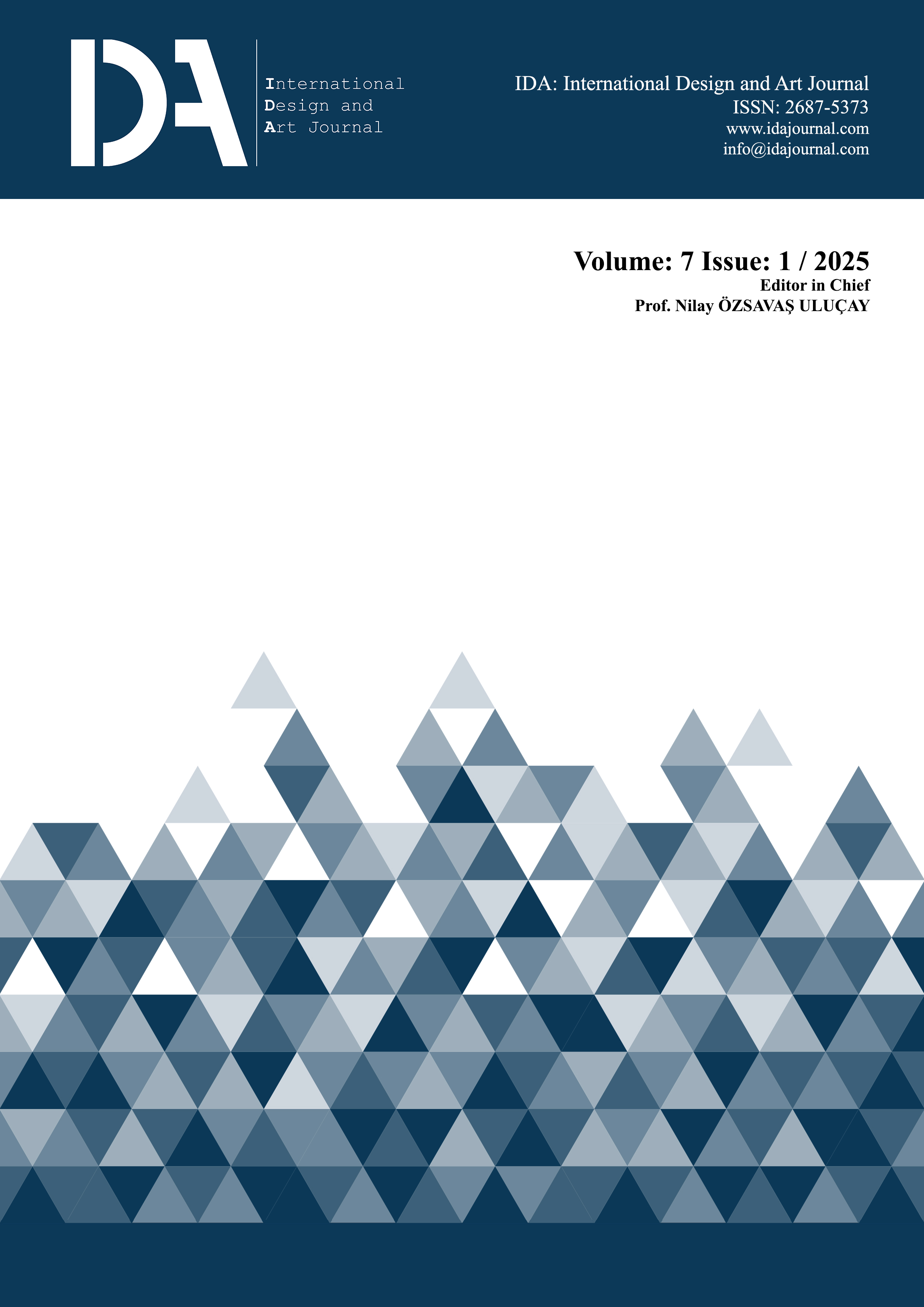Text to image: A creative transformation in furniture design with artificial intelligence
Keywords:
Generative artificial intelligence, Furniture design, Functionality, Text guided image synthesis, Interior architectureAbstract
This study examines the role and impact of generative artificial intelligence in the furniture design process. The study examines the use of artificial intelligence-assisted design tools to analyze how the designs produced with these tools compare with the original designs and evaluates the level of similarity, originality, and creativity. To minimize the risk of artificial intelligence copying verbatim designs that are often processed by platforms, a lesser-known design, Miss Dior: The Medallion Chair was preferred. This method was followed to reduce potential biases and enable a more realistic evaluation. The research covers Microsoft Bing, Adobe Firefly and Leonardo AI, three popular artificial intelligence applications with text-to-visual conversion. The prompts created for the selected furniture were entered into artificial intelligence applications determined within the scope of the experimental research method and the outputs were compared. Especially Leonardo AI produced faster, higher-quality, and more consistent results. Data analysis and the potential to create designs that better meet user needs are features of these tools. However, in design processes, the role of human creativity and artistic thinking is always the main element. Artificial intelligence, on the other hand, should be considered as a tool to support the creative process rather than a replacement for the designer.
References
Akın, E. & Şahin, M. E. (2024). Derin öğrenme ve yapay sinir ağı modelleri üzerine bir inceleme. EMO Bilimsel Dergi, 14(1), 27-38.
Arslan, K. (2020). Eğitimde yapay zekâ ve uygulamaları. Batı Anadolu Eğitim Bilimleri Dergisi, 11(1), 71-88.
Aslan, F. (2024). Öznemekanların arakesitiyle kurgulanan bir temsil anlatısı: Tasarımın yaratıcı süreçlerinde yapay zeka [Yüksek Lisans Tezi, İstanbul Teknik Üniversitesi]. YÖK Ulusal Tez Merkezi.
Aslan, T. & Aydın, K. (2023). Metinden görüntü üretme potansiyeli olan yapay zekâ sistemleri: Sanat ve tasarım performanslarının incelenmesi. Ondokuz Mayıs Üniversitesi Eğitim Fakültesi Dergisi, 42(2), 1049-1198. https://doi.org/10.7822/omuefd.1293657
Elfayoumy, A. H., Abdel Rahman, A., & Oreaba, A. A. S. (2025). AI-driven furniture design: Bridging creativity and manufacturability in the digital age. The International Design Journal, 15(2), 105-113.
Kahvecioğlu, C., Ast, M. C., & Sağlık, A. (2024). Peyzaj tasarımında yapay zekâ araçlarının kullanımı. E. Sağlık (Ed.). İKSAD Yayınevi.
Karabulut, B. (2021). Yapay zekâ bağlamında yaratıcılık ve görsel tasarımın geleceği. Elektronik Sosyal Bilimler Dergisi, 20(79), 1516-1539. https://doi.org/10.17755/esosder.844536
Karadağ, D. (2024). Yapay zekâ ve insan: Tasarım dünyasında yeni perspektifler. XXI. https://xxi.com.tr/i/yapay-zeka-ve-insan (20.01.2025).
Karaman, M. (2024). Use of artificial intelligence technologies in visual design. Medeniyet Sanat Dergisi, 10(2), 121-138. https://doi.org/10.46641/medeniyetsanat.1525769
Li, C., Zhang, T., Du, X., Zhang, Y., & Xie, H. (2024). Generative AI models for different steps in architectural design: A literature review (arXiv No. 2404.01335). arXiv. https://arxiv.org/abs/2404.01335
Mutlu Avunç, G. (2024). Mimaride biyofilik tasarım için metinden görüntü üretme potansiyeli olan yapay zekâ araçlarının kullanımı. Black Sea Journal of Engineering and Science, 7(4), 641-648. https://doi.org/10.34248/bsengineering.1470411
Sivri, O. (2024). Yapay zekâ çerçevesinde görsel sanatların geleceği. İnsanat Sanat Tasarım ve Mimarlık Araştırmaları Dergisi, 4(1), 322-344.
Şen, E. (2022). İllüstrasyon alanında yapay zekâ uygulamaları. Abant Sosyal Bilimler Dergisi, 22(3), 1320-1332. https://doi.org/10.11616/asbi.1159662
Tatlisu, E., Bağlı, H. H., Turan, A. Z., Hamurcu, A., Eser, A., Avcı, S. K. (2025). Yapay zekâ çağında endüstriyel tasarım: Uygulamalar ve eğitim üzerine etkileri. Öneri Dergisi, 20(MX Yaratıcı Endüstriler Çalıştayı 2024: Yapay Zekâ Çağında Yaratıcı Endüstriler Özel Sayısı), 154-188.
Turan Başara, G. (2024). Avrupa dijital düzenleme sisteminde yapay zekâ yasası. Ankara Üniversitesi Hukuk Fakültesi Dergisi, 73(4), 2983-3016. https://doi.org/10.33629/auhfd.1578021
Ünsal, H. (2024). Yapay zekâ ve yapay zekânın eğitimin geleceğine ilişkin olası doğurguları. Journal of Social, Humanities and Administrative Sciences (JOSHAS), 10(5), 674-682.
Yavuz Öden, H. (2021). Mobilya tasarımında eskiz ve biçime etkileri. Avrasya Sosyal ve Ekonomi Araştırmaları Dergisi, 8(3), 866-882.
Yıldırım, B. (2024). Yapay zekâ sanatının doğal ve yapay kavramına tarihsel süreçte etkisi. Felsefe Dünyası, 79, 280-306. https://doi.org/10.58634/felsefedunyasi.1489983
Yıldırım, B. & Kavut, İ. E. (2024). Zihinsel imgenin mekânsal izdüşümünü üretken yapay zekâ aracılığıyla temsil etmek: Puslu kıtalar atlası örneği. International Design and Art Journal, 6(2), 233-248.
Downloads
Published
Issue
Section
License
Copyright (c) 2025 IDA: International Design and Art Journal

This work is licensed under a Creative Commons Attribution-NonCommercial-ShareAlike 4.0 International License.
IDA: International Design and Art Journal is an open-access academic journal. All publishing rights of the accepted articles are deemed to assign to IDA: International Design and Art Journal. Articles can not be published and copied anywhere, and can not be used without reference.
IDA: International Design and Art Journal is licensed under a Creative Commons Attribution-NonCommercial-ShareAlike 4.0 International License.



